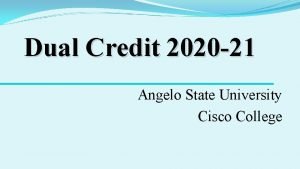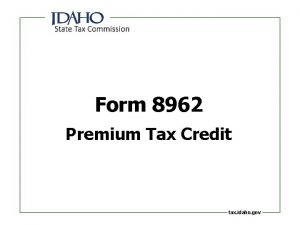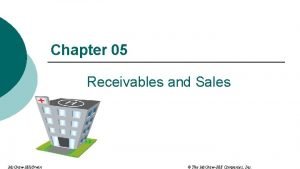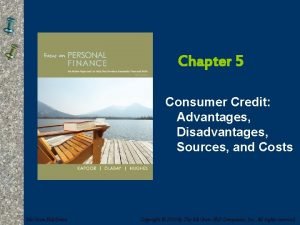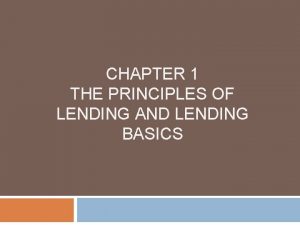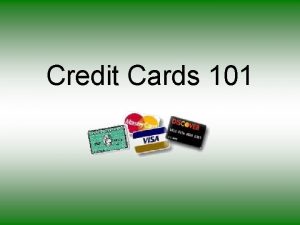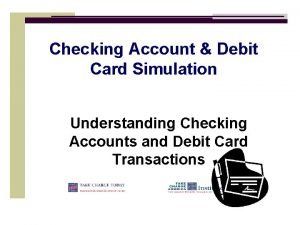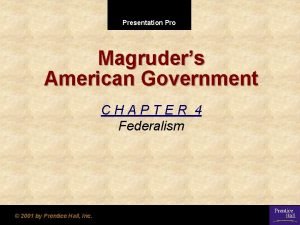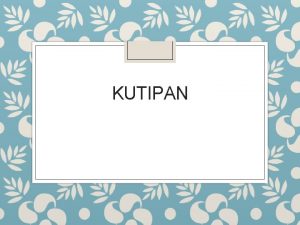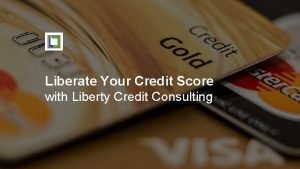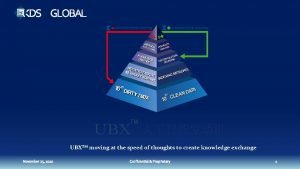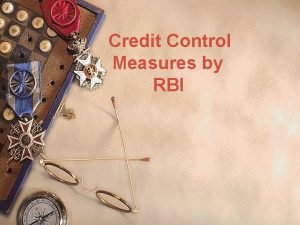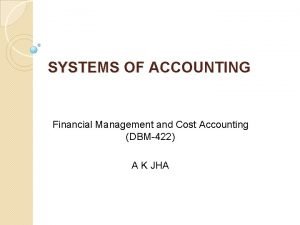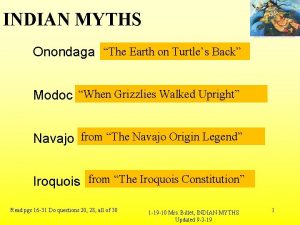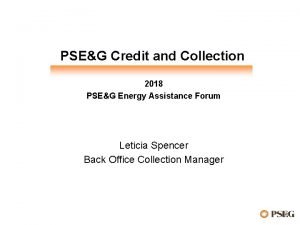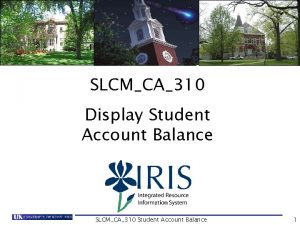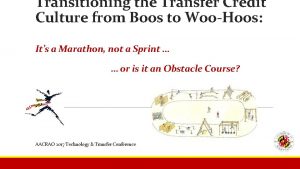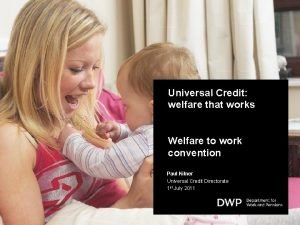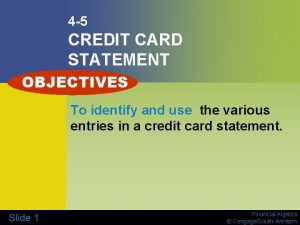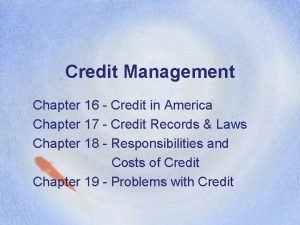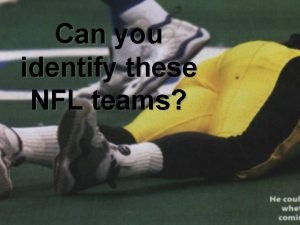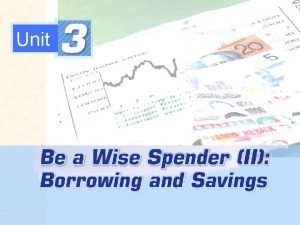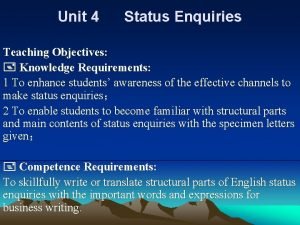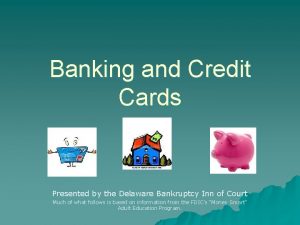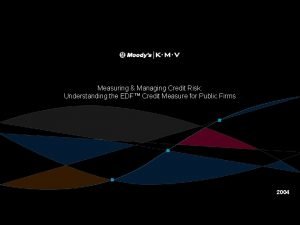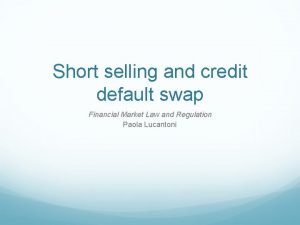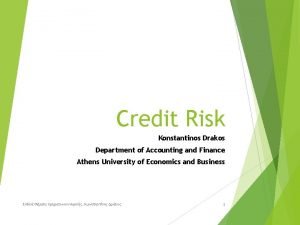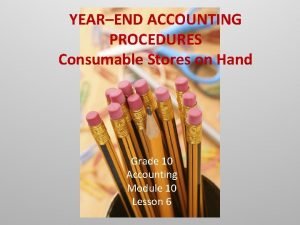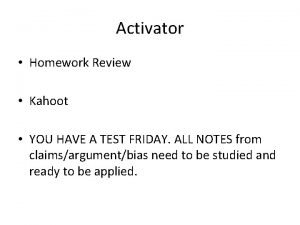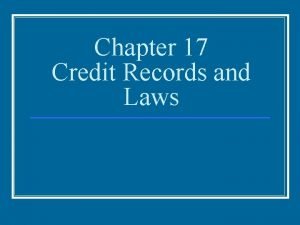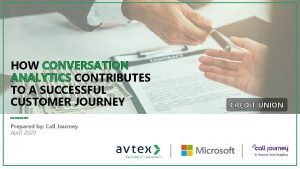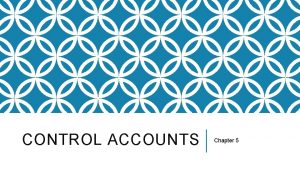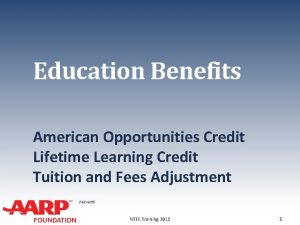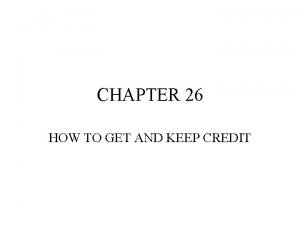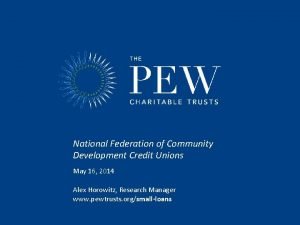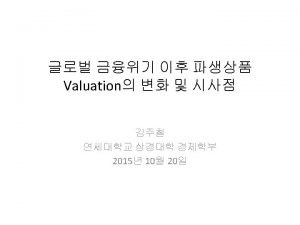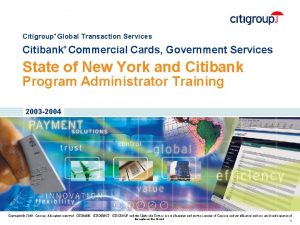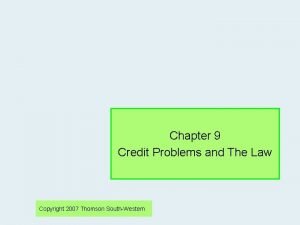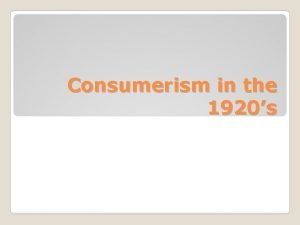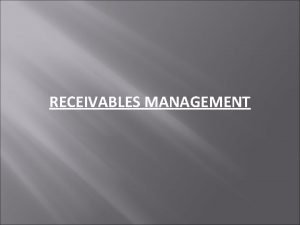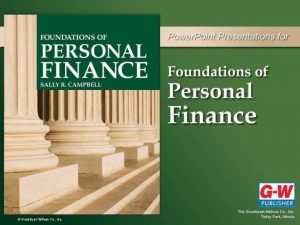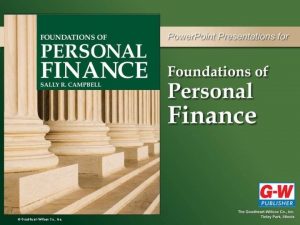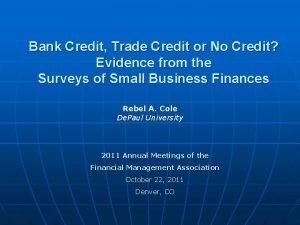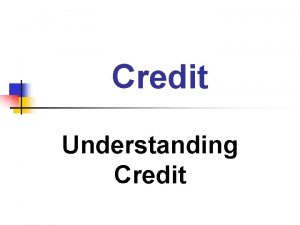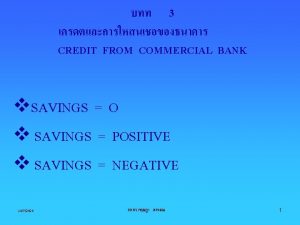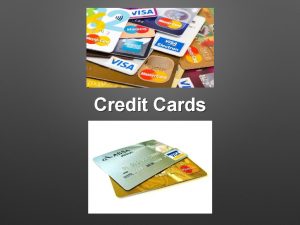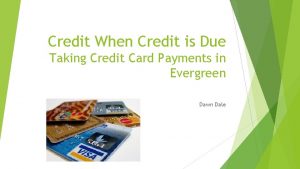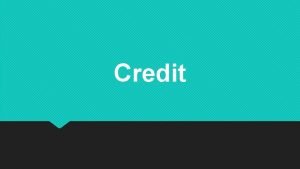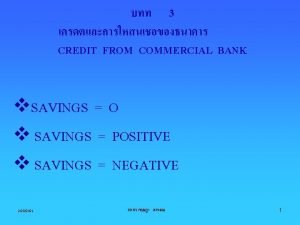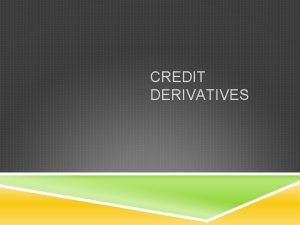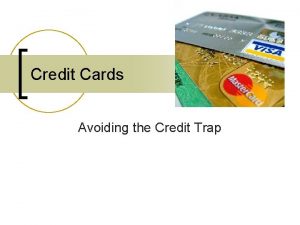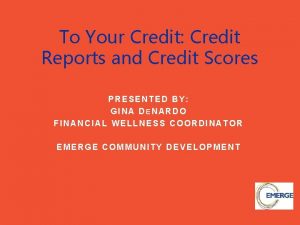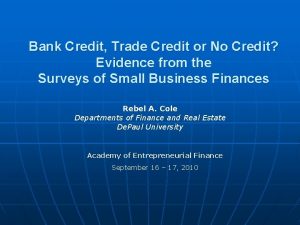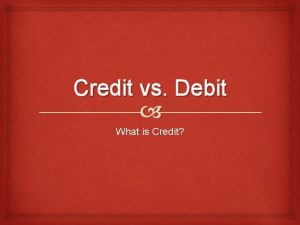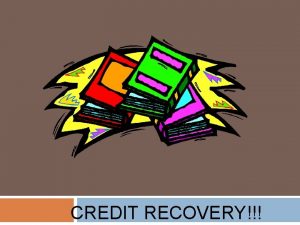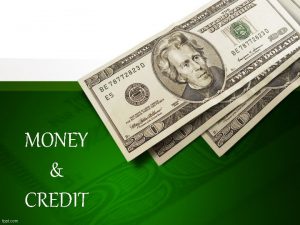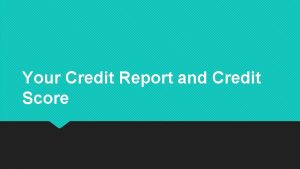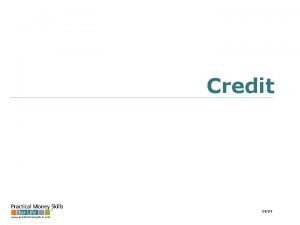GoodheartWillcox Co Inc 1 9 Credit GoodheartWillcox Co






























































- Slides: 62

© Goodheart-Willcox Co. , Inc. 1

9 Credit © Goodheart-Willcox Co. , Inc. 2

Chapter Objectives • Explain the advantages and disadvantages of using credit. • Identify the different types of consumer credit. • Describe how to establish a sound credit rating. • Define the key terms in credit contracts and agreements. © Goodheart-Willcox Co. , Inc. 3 continued

Chapter Objectives • Compare credit terms and charges. • Outline the steps involved in managing credit. • Identify steps to take in resolving credit problems. • Summarize the laws that govern the use of credit. © Goodheart-Willcox Co. , Inc. 4

Understanding Consumer Credit • Credit plays an important role in the economy • Provides extra buying power that supports mass production and distribution – Helps make more goods and services available to consumers at lower prices © Goodheart-Willcox Co. , Inc. 5 continued

Understanding Consumer Credit • Credit is a medium of exchange • It is an agreement between two parties – Creditor supplies money, goods, or services to the borrower – Borrower agrees to make future payment by a particular date or according to an agreed-upon schedule © Goodheart-Willcox Co. , Inc. 6 continued

Understanding Consumer Credit • There is a risk that the borrower cannot repay what is owed • Creditors minimize risk by – having borrowers sign a contract – taking a borrower who defaults to court and even taking back property © Goodheart-Willcox Co. , Inc. 7

Reasons to Use Credit • Gives you the opportunity to buy costly items that you may not be able to buy with cash © Goodheart-Willcox Co. , Inc. 8 continued

Reasons to Use Credit • You can use goods and services as you pay for them • Credit can be used as a source of cash for emergencies and unexpected expenses • You can take advantage of sale prices when you don’t have cash © Goodheart-Willcox Co. , Inc. 9 continued

Reasons to Use Credit • Convenience – eliminates the need to carry a lot of cash – provides a purchase record – simplifies shopping by phone, mail, and Internet • You can make purchases that are part of a long-range financial plan: education, furniture, vacation © Goodheart-Willcox Co. , Inc. 10

Drawbacks of Credit Use • Using credit reduces future income • Expense—using credit costs money (finance charges) • Temptation—using credit makes it easy to spend money you don’t have • Risk of serious consequences—financial problems arise when debts aren’t paid on time and in full © Goodheart-Willcox Co. , Inc. 11

Cost of Credit • Using credit is more costly than paying with cash © Goodheart-Willcox Co. , Inc. 12 continued

Cost of Credit • Borrowers must pay principal plus finance charges • Finance charges reimburse creditors for – the costs of making credit available – taking the risk that borrowers may default © Goodheart-Willcox Co. , Inc. 13 continued

Cost of Credit • Creditors – may borrow money to make credit available; when they borrow, they must also pay interest – lose the chance to invest money – incur costs for opening and servicing credit accounts – absorb losses of unpaid accounts and cost of collecting overdue debts © Goodheart-Willcox Co. , Inc. 14

Finance Charges • Are the dollar amounts paid for credit • Consist of two parts: interest and fees • Are expressed as percentages © Goodheart-Willcox Co. , Inc. 15

In Your Opinion • Have you ever lent money to a friend? Based on your experience, do you think creditors deserve to be paid a finance charge? © Goodheart-Willcox Co. , Inc. 16

Annual Percentage Rate (APR) • The higher the APR, the more you pay • Example: Interest for a $500 loan repaid in 12 monthly payments would cost – $50. 08 at 18% – $58. 72 at 21% – $67. 36 at 24% © Goodheart-Willcox Co. , Inc. 17

Amount of Credit Used • The more credit you use, the more you pay • Example: Interest on a loan repaid in 12 monthly payments at an APR of 18% would cost – $50. 08 for a $500 loan – $110. 01 for a $1, 000 loan – $220. 02 for a $2, 000 loan © Goodheart-Willcox Co. , Inc. 18

Length of Repayment Period • The longer you take to repay what you borrowed, the more you pay • Example: Interest on a $500 loan at 1. 5% per month (18% APR) would cost – $50. 08 if repaid in 12 monthly payments – $99. 44 if repaid in 24 monthly payments – $150. 88 if repaid in 36 monthly payments © Goodheart-Willcox Co. , Inc. 19

Types of Credit • Closed-end credit must be repaid by a certain date • Open-end credit allows the borrower to use money for an indefinite period © Goodheart-Willcox Co. , Inc. 20

Closed-End Credit • Most are installment loans that let you borrow a given amount of money and repay it with interest in regular installments • Examples: student loans, car loans, most home loans © Goodheart-Willcox Co. , Inc. 21 continued

Closed-End Credit • A secured loan requires collateral— finance charges may be lower because creditor can take property if loan is not repaid • An unsecured loan—finance charges are usually higher because no collateral; borrower must have strong credit rating or a cosigner © Goodheart-Willcox Co. , Inc. 22

Open-End Credit • Borrower can continue to use credit if he or she makes scheduled payments, pays finance charges, and stays within borrowing limit – Regular charge accounts – Revolving credit accounts • Offered by retailers, merchants, banks, credit agencies © Goodheart-Willcox Co. , Inc. 23 continued

Open-End Credit • You must make at least the minimum payment each month • Total amount you may owe at any one time is limited © Goodheart-Willcox Co. , Inc. 24

Establishing Credit • • Start with a job Open a savings account Open a checking account Apply for a credit card at a local department store or gas company © Goodheart-Willcox Co. , Inc. 25

Your Credit Rating • Determines whether you can get credit and what you will pay for it • Is measured by the three Cs—character, capacity, and capital • A creditworthy applicant is judged to have the assets, income, and tendency to repay debt © Goodheart-Willcox Co. , Inc. 26

The Credit Report • Three major national agencies sell credit reports to creditors • Each agency collects information about financial and credit transactions • The information on these reports often differs • Carefully review your credit reports and report errors to agencies © Goodheart-Willcox Co. , Inc. 27 continued

The Credit Report • The report lists – every credit account ever opened – outstanding balances – negative data, such as late payments, unpaid debts, bankruptcy © Goodheart-Willcox Co. , Inc. 28

Credit Scores • A credit score is a numerical measure of a loan applicant’s creditworthiness • The higher the score, the greater a person’s creditworthiness • The lower the score, – the more trouble you will have getting credit – the more expensive credit will be © Goodheart-Willcox Co. , Inc. 29 continued

Credit Scores • Credit score factors: – Bill paying – Debt-to-credit-limit-ratio – Credit history length – Recent credit application – Different types of credit • You may have more than one credit score generated by different agencies © Goodheart-Willcox Co. , Inc. 30

Getting a Credit Card • Common types of credit cards include – general-purpose – company or retail store – travel and entertainment © Goodheart-Willcox Co. , Inc. 31

Shopping for a Credit Card • Understand possible fees, penalties, and consequences of failing to carry out the terms of the agreement • Be wary of acceleration clauses, balloon payments, and add-on clauses © Goodheart-Willcox Co. , Inc. 32

The Contract • Read the contract (application) thoroughly before signing it © Goodheart-Willcox Co. , Inc. 33

Disclosures • Annual percentage rates: – What is the APR? – How long will a lower introductory rate last? What is the regular rate? – Can the rate be raised for any reason? – Is the rate fixed or variable? © Goodheart-Willcox Co. , Inc. 34 continued

Disclosures • What is the grace period? • What method is used to calculate the interest rate? • Is there an annual fee? If so, how much? • What are fees for – late payments – exceeding credit limit – cash advances – balance transfers © Goodheart-Willcox Co. , Inc. 35

Subprime Credit Cards • Easier to get; offered to those with poor credit histories • Often carry high interest rates, large annual fees, and other charges • Low credit limits • Often a bad deal for consumers © Goodheart-Willcox Co. , Inc. 36

Managing Your Credit • Know your financial personality. • What are your money attitudes and habits? © Goodheart-Willcox Co. , Inc. 37 continued

Managing Your Credit • Keep track of spending – Create a budget – Don’t use more credit than you can pay off each month – Save your receipts and keep a log of credit charges © Goodheart-Willcox Co. , Inc. 38

Remember Alternatives to Using Credit • Not to buy • Pay with savings • Postpone buying now and buy later with cash © Goodheart-Willcox Co. , Inc. 39

Check Monthly Statements • Check statements against your own record of charges, payments, and credits © Goodheart-Willcox Co. , Inc. 40

Check Your Credit Report Regularly • Find and correct errors immediately • Make sure no one has applied for credit in your name © Goodheart-Willcox Co. , Inc. 41

Report Lost or Stolen Cards • Keep a list of your credit cards—issuers, account numbers, issuer phone numbers • Report lost or stolen cards right away • If your card is lost or stolen, you are responsible for – $50 per card that is charged by others – no charges made by others if you notify the issuer before the card is used © Goodheart-Willcox Co. , Inc. 42

Handling Credit Problems • Poor credit use consequences: – Inability to get loans and credit cards – Paying higher interest rates for credit – Having fewer housing choices – Having fewer job prospects because many employers check credit reports – Paying higher insurance premiums © Goodheart-Willcox Co. , Inc. 43 continued

Handling Credit Problems • Blemishes on credit reports: – Accurate negative information, such as missed or late payments, may remain on your report for seven years – Bankruptcies may remain on your report for 10 years © Goodheart-Willcox Co. , Inc. 44 continued

In Your Opinion • Would you cosign a loan for your best friend or a family member if doing so would endanger your credit rating? © Goodheart-Willcox Co. , Inc. 45

Handling Credit Problems • Actions taken to recover debts: – Collection agencies are hired to get payment – Repossession of property, including foreclosure – Liens against property – Wage garnishment © Goodheart-Willcox Co. , Inc. 46

Bankruptcy • Desperate debtors last resort—file for personal bankruptcy – Court excuses debtor from repaying some or all debt – Debtor gives up certain assets and possessions • Two types—Chapter 7 and Chapter 13 • Consequences of bankruptcy are severe © Goodheart-Willcox Co. , Inc. 47

The Easy-Access Credit Trap • Easy-access credit includes – payday loans – pawnshops – rent-to-own – title loans • A loan shark is someone who uses predatory lending tactics and easyaccess credit © Goodheart-Willcox Co. , Inc. 48

Inform Creditors • They may change payment dates and amounts if you have trouble paying bills © Goodheart-Willcox Co. , Inc. 49

Get Credit Counseling • Use reputable nonprofit credit counseling services • Avoid credit counseling firms that – charge high fees – demand that the debtor pay them rather than their creditors © Goodheart-Willcox Co. , Inc. 50

Consumer Credit Legislation • Truth in Lending Law requires creditors to tell consumers what credit will cost • Equal Credit Opportunity Act prohibits creditors from discriminating against consumers • Fair Credit Reporting Act requires accuracy and privacy of credit report information © Goodheart-Willcox Co. , Inc. 51 continued

Consumer Credit Legislation • Fair Credit Billing Act protects consumers from unfair billing practices • Electronic Funds Transfer Act protects consumers in EFT transactions • Fair Debt Collection Practices Act protects consumers against unfair methods of collecting debts © Goodheart-Willcox Co. , Inc. 52 continued

Consumer Credit Legislation • Preservation of Consumers’ Claims and Defenses Ruling protects debtors who have a legitimate dispute with a seller • Bankruptcy Abuse Prevention and Consumer Protection Act – was meant to increase fairness of the bankruptcy system – makes filing for bankruptcy more difficult © Goodheart-Willcox Co. , Inc. 53

Central Ideas of the Chapter • Credit is a powerful financial management tool. • Serious financial problems result from the misuse of credit. © Goodheart-Willcox Co. , Inc. 54

Glossary of Key Terms Back • annual percentage rate (APR). The annual cost of credit a lender charges. • bankruptcy. A legal state in which the courts excuse a debtor from repaying some or all debt. In return, the debtor must give up certain assets and possessions. • closed-end credit. A loan that must be repaid with finance charges by a certain date. © Goodheart-Willcox Co. , Inc. 55

Glossary of Key Terms Back • collateral. Property that a borrower promises to give up in case of default. • contract. A legally binding agreement between a borrower and a creditor. • cosigner. A responsible person who signs a loan along with a borrower thereby agreeing to pay the obligation if the borrower fails to do so. © Goodheart-Willcox Co. , Inc. 56

Glossary of Key Terms Back • credit. An arrangement that allows consumers to buy goods or services and pay for them later. • credit card. Allows consumers to make purchases or borrow money on a timepayment plan. • creditor. The party that supplies money, goods, or services in a credit agreement. © Goodheart-Willcox Co. , Inc. 57

Glossary of Key Terms Back • credit report. A record of a person’s credit history and financial behavior. • creditworthy. A credit applicant judged to have the assets, income, and tendency to repay debt. • default. When a borrower fails to pay the debt owed. © Goodheart-Willcox Co. , Inc. 58

Glossary of Key Terms Back • easy-access credit. A short-term, high-interest loan granted to borrowers regardless of credit history. • foreclosure. The forced sale of a property. • garnishment. A legal procedure requiring a portion of a debtor’s pay to be set aside by the person’s employer to pay creditors. © Goodheart-Willcox Co. , Inc. 59

Glossary of Key Terms Back • grace period. The time between the billing date and the start of interest charges. • lien. A legal claim on a borrower’s property by a creditor who is owed money. • loan shark. Someone who loans money at excessive rates of interest. • open-end credit. Allows the borrower to use a certain amount of money for an indefinite period of time. © Goodheart-Willcox Co. , Inc. 60

Glossary of Key Terms Back • pawnshop. A business that gives customers high-interest loans with personal property, such as jewelry, held as collateral. • payday loan. A short-term, high interest loan that must usually be repaid on the borrower’s next payday. • principal. The amount borrowed on a loan. © Goodheart-Willcox Co. , Inc. 61

Glossary of Key Terms Back • rent-to-own. A credit arrangement in which a consumer pays rent for the use of a product and eventually owns it. • repossession. A lender takes back collateral when a borrower fails to repay a loan. • secured loan. A loan that requires collateral. • title loan. A loan made using the borrower’s car as collateral. © Goodheart-Willcox Co. , Inc. 62
 This can be avoided by giving credit where credit is due.
This can be avoided by giving credit where credit is due. Campus connect cisco college
Campus connect cisco college Form 8962 premium tax credit
Form 8962 premium tax credit Ung cost per credit hour
Ung cost per credit hour Note receivable debit or credit
Note receivable debit or credit Owner's capital debit or credit
Owner's capital debit or credit What are the disadvantages of consumer credit
What are the disadvantages of consumer credit Liquidity measures
Liquidity measures Grayson college dual credit
Grayson college dual credit Dr martin goldberg
Dr martin goldberg Principles of credit analysis
Principles of credit analysis Credit card 101
Credit card 101 Checkbook simulation answers
Checkbook simulation answers Chapter 4 federalism
Chapter 4 federalism Kutipan adalah
Kutipan adalah Liberty credit consulting
Liberty credit consulting Aft prepayment and credit model
Aft prepayment and credit model Credit counselling owen sound
Credit counselling owen sound Credit control measures by rbi
Credit control measures by rbi Debit credit rules
Debit credit rules Identify the stages of the navajo creation ceremony
Identify the stages of the navajo creation ceremony Ukrainian national association
Ukrainian national association Pse&g collections
Pse&g collections Piqst
Piqst Anz risk management framework
Anz risk management framework Disadvantages of debit cards
Disadvantages of debit cards Umd transfer credit
Umd transfer credit Letter of credit
Letter of credit Carers allowance and universal credit
Carers allowance and universal credit Types of headline in newspaper
Types of headline in newspaper 4-5 credit card statement
4-5 credit card statement Chapter 16 credit in america
Chapter 16 credit in america Six shooters nfl team
Six shooters nfl team The minimum monthly payment for janet's credit card is 2%
The minimum monthly payment for janet's credit card is 2% Credit and status enquiries letter
Credit and status enquiries letter How many types of credit are there?
How many types of credit are there? Klein isd dual credit
Klein isd dual credit Measuring and managing credit risk
Measuring and managing credit risk Short position meaning
Short position meaning Credit transition matrix
Credit transition matrix Photo credit
Photo credit Crutchfield credit card
Crutchfield credit card Consumable stores on hand in income statement
Consumable stores on hand in income statement Michigan historic tax credit
Michigan historic tax credit Kahoot persuasive techniques
Kahoot persuasive techniques Chapter 17 credit records and laws
Chapter 17 credit records and laws Avtex credit union crm
Avtex credit union crm Debtors account shows balance
Debtors account shows balance What is the credit limit worksheet for form 8863?
What is the credit limit worksheet for form 8863? Photo credit
Photo credit Dorsal lip of the blastopore
Dorsal lip of the blastopore Chapter 26 how to get and keep credit worksheet answers
Chapter 26 how to get and keep credit worksheet answers National federation of community development credit unions
National federation of community development credit unions Funding value adjustment
Funding value adjustment Credit default swap in india
Credit default swap in india Excelsior scholarship gpa requirements
Excelsior scholarship gpa requirements United credit education services cost
United credit education services cost Citibank commercial credit card
Citibank commercial credit card Chapter 9 credit problems and laws
Chapter 9 credit problems and laws Consumerism in the 1920s
Consumerism in the 1920s Credit standards in receivable management
Credit standards in receivable management Lamination plates for credit cards
Lamination plates for credit cards Msc credit rating
Msc credit rating

